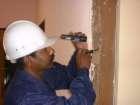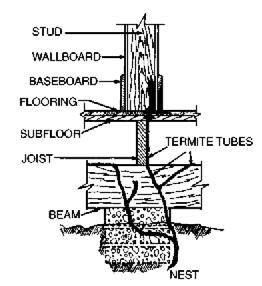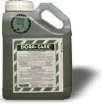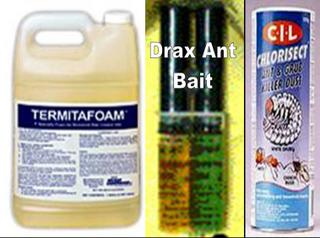 As requested by Phua, I repost this article I wrote on September 2005. It is just a short brief on the subject of white ants.
As requested by Phua, I repost this article I wrote on September 2005. It is just a short brief on the subject of white ants.You don’t know they are there until it’s too late.
They are the unseen enemy.
 Each year, the damages caused by this insects are more than the total damages from floods and fires combined.
Each year, the damages caused by this insects are more than the total damages from floods and fires combined.On September 11, 2005, teacher Chan Boon Heng of SRJK (C) Keat Hwa (K) in Jalan Seberang Perak dies of internal injuries when he plunged 15 feet down due to the collapse of the plywood floorboard in the school which had been infested by white ants.
Chan was at the school’s office located on the first floor at 7.30am when the rotting wooden plywood floorboard suddenly gave way, and he plunged 15 feet down onto the hard cement floor below. He was rushed to a nearby private hospital where he died of internal injuries.
 As our governmental system are basically reactive, on September 20, Education Minister Datuk Seri Hishamuddin announced that the government has now approved RM10 million for repairs and upgrading of schools following the death of teacher Chan Boon Heng. Hishamuddin said the number of schools that needed repair were huge which is why schools deemed “really dangerous” would be given priority. He said he did not blame anyone for the insufficient allocation. “We have already spent a lot on equipments and computer laboratories. So, we now hear the mourning over the fact that billions are spent building computer labs, installing Astro and paying multi-millions for the TV programmes and building hostels worth hundreds of millions; but no money to repair and upkeep schools, in particular, national-type schools and religious schools, and no money to repair dilapidated bridges in kampungs too.
As our governmental system are basically reactive, on September 20, Education Minister Datuk Seri Hishamuddin announced that the government has now approved RM10 million for repairs and upgrading of schools following the death of teacher Chan Boon Heng. Hishamuddin said the number of schools that needed repair were huge which is why schools deemed “really dangerous” would be given priority. He said he did not blame anyone for the insufficient allocation. “We have already spent a lot on equipments and computer laboratories. So, we now hear the mourning over the fact that billions are spent building computer labs, installing Astro and paying multi-millions for the TV programmes and building hostels worth hundreds of millions; but no money to repair and upkeep schools, in particular, national-type schools and religious schools, and no money to repair dilapidated bridges in kampungs too.
What caused the plywood floorboards to rot and yet is not visible to the naked eyes ?
Termites! White-ants!
 Termites can be found in almost all homes of every age and types - whether the houses are new or old; whether it is built of brick or wood.
Termites can be found in almost all homes of every age and types - whether the houses are new or old; whether it is built of brick or wood.These termites multiplies quickly in the warm, humid climate of our country. And when they do, they caused behemoth damages which can be extremely costly to repair and rectify.
Subterranean termites (order isoptera) or what we face in our homes which we call 'white-ants', normally travel constantly from their nests in the ground to the wood, or other cellulose-bearing material upon which they feed. They make these trips only inside wood or in the mud tubes which they construct.
 Subterranean termites are always found at or near ground level. Their entrance to buildings are by squeezing through the cracks in the concrete slab or in between the bricks and cement plaster.
Subterranean termites are always found at or near ground level. Their entrance to buildings are by squeezing through the cracks in the concrete slab or in between the bricks and cement plaster.Once a building has termites infestation, many more colonies would have already existed under the substructure foundation of the building.
 Wood damaged by termites cannot be seen with our naked eyes because the exterior surface (the wood skin) hide the damages and can only be seen if we removed the outer skin of the wood to see the damage. However, galleries can be detected by tapping the wood every few inches with the handle of a hard object such as a hammer or screwdriver. Damaged wood sounds hollow, and the screwdriver may even break through into the galleries.
Wood damaged by termites cannot be seen with our naked eyes because the exterior surface (the wood skin) hide the damages and can only be seen if we removed the outer skin of the wood to see the damage. However, galleries can be detected by tapping the wood every few inches with the handle of a hard object such as a hammer or screwdriver. Damaged wood sounds hollow, and the screwdriver may even break through into the galleries.  Termite feeding follows the grain of the wood and only the soft springwood is attacked. Unlike drywood termites or other wood-boring insects, these subterranean termites do not push wood particles or pellets (fecal material) to the outside, but rather use it in the construction of their tunnels. This debris, along with sand and soil particles, is used as a form of plaster.
Termite feeding follows the grain of the wood and only the soft springwood is attacked. Unlike drywood termites or other wood-boring insects, these subterranean termites do not push wood particles or pellets (fecal material) to the outside, but rather use it in the construction of their tunnels. This debris, along with sand and soil particles, is used as a form of plaster. Therefore, it is highly recommended that the building's structural foundation is to be treated with chemical mixture as to create a barrier from further termites attacks.
Therefore, it is highly recommended that the building's structural foundation is to be treated with chemical mixture as to create a barrier from further termites attacks.The best control against infestation of termites is definitely prevention. The best time to provide protection against termites is always during the planning and construction of a building. Prevention should include:
Removal of all stumps, roots, wood, and similar materials from the building site before construction is begun.
Removal of all form boards and grade stakes used in construction.
There should be no contact between the building woodwork and the soil or fill. Exterior woodwork should be located a minimum of 6 inches above ground and beams in crawl spaces at least 18 inches above ground to provide ample space to make future inspections.
Ventilation openings in foundations should be designed to prevent dead air pockets and of sufficient size to assure frequent changes of air. This helps keep the ground dry and unfavorable for termites.
Landscape plants and irrigation should not be placed within two feet of the foundation wall.
Thorough annual inspections should be conducted to discover evidence of wood damage or termite activity such as shelter tubes on foundation surfaces, discarded wings or adult termites.
Any wood that contacts the soil, such as fence posts, poles and general foundation structures, should be commercially pressure treated (tanalising or what we call 'green treatment), and should not be attached to house.
The treatment is specifically to be carried out at the structural foundation of the buildings. It will be done at the external and internal side of the building. The purpose is to create chemical barrier to building foundation to prevent entrance of new colonies into the building from the ground.
Controlling the infestation of termites by preventing the termite colony in the soil from entering the structure is the foremost objective. A thorough pre-construction treatment should be applied to protect the structure for at least 5 to 10 years. Houses treated with chlorinated hydrocarbons, such as chlordane or heptachlor, can provide protection against termites for up to 30 years.
TREATMENT SPECIFICATIONS
 Drilling is done at the interior (hardcore) and the exterior (aprons) side of the premises.
Drilling is done at the interior (hardcore) and the exterior (aprons) side of the premises.Drilling will be carried out through the concrete slab to the surface of the soil bed beneath the hardcore.
Each hole is between 18" to 24" apart and is drilled 4" away from the wall-footings. The size of each hole is 1/2" in diameter and 24" deep into the compacted soil.
A chemical mixture equivalent to 5 liters is injected under pressure into each hole. Should there be no existing aprons, trenching will be carried out. Chemical mixture equivalent to 5 liters to one linear meter will be applied to the trenches prior to backfill of soil onto them.
Finally, each hole is patched with cement.
CHEMICAL AND APPLICATION
The chemical such as chlordane, heptachlor, and chlorpyrifos based with an aqueous emulsion at a concentration of one (1) percent can be used. This chemical is to be applied at the rate of 5 liters per injection per hole.
Because of concern about damage to the environment and harm to human health, the Environmental Protection Agency (EPA) banned all uses of chlordane in 1983 except to control termites. In 1988, EPA banned all uses.
The Environmental Protection Agency has banned the sale of heptachlor products in the United States and virtually eliminated its use for any purpose.
Chlorpyrifos is a toxic crystalline organophosphate pesticide (C9H11Cl3NO3PS) that inhibits acetylcholinesterase and is used to control insect pests. Trade names include Dursban, Empire, Eradex, Lorsban, and Stipend. Its chemical name is O,O-diethyl O-3,5,6-trichloro-2-pyridyl phosphorothioate.
The recommended chemicals are chlorpyrifos, fenvalerate, permethrin, cypermethrin, and bendiocarb. The manufacturers are such as Dow Chemical Company, ICI Chemical Company, Roussel Bio Corporation, Nor-Am Chemical Co, Chevron Chemical Co, etc.
All chemical used must be of the approved type by the Pesticide Board of Malaysia. Only the recommended dosage by the manufacturer will be used to achieve the optimum result.
Soil treatment shall not be carried out when the soil is saturated or excessively wet (for example, during or after a rainfall) or when it is likely to rain.
 There are two general categories of termiticides that are differentiated by how termite tunneling is affected when they encounter an effective soil treatment. The first category is referred to as a, "Repellent Termiticide." All of the synthetic chemicals classified as "Repellent Termiticides" are pyrethroids. The name "Repellent Termiticide," is ambiguous; the chemical properties of the soil treatment only repel termites from the structure. "Repellent Termiticides" do not kill termites because they are able to detect the soil treatment. Since the termites are able to detect the treated soil they do not tunnel into the treated soil barrier.
There are two general categories of termiticides that are differentiated by how termite tunneling is affected when they encounter an effective soil treatment. The first category is referred to as a, "Repellent Termiticide." All of the synthetic chemicals classified as "Repellent Termiticides" are pyrethroids. The name "Repellent Termiticide," is ambiguous; the chemical properties of the soil treatment only repel termites from the structure. "Repellent Termiticides" do not kill termites because they are able to detect the soil treatment. Since the termites are able to detect the treated soil they do not tunnel into the treated soil barrier. The other category is referred to as a "Non-Repellent Termiticide." Termite tunneling is not affected by a "Non-Repellent Termiticide" soil treatment because the termites are unable to detect the treated soil. Since they continue to tunnel freely through the treated soil they become exposed to the "Non Repellent Termiticide" by contact or ingestion and will die. Both repellent and non-repellent termiticides have proven satisfactory for making effective barriers when applied properly.
The other category is referred to as a "Non-Repellent Termiticide." Termite tunneling is not affected by a "Non-Repellent Termiticide" soil treatment because the termites are unable to detect the treated soil. Since they continue to tunnel freely through the treated soil they become exposed to the "Non Repellent Termiticide" by contact or ingestion and will die. Both repellent and non-repellent termiticides have proven satisfactory for making effective barriers when applied properly. The integrity of the soil treatment is a key factor in providing protection to the structure. A repellent termiticide properly applied to the soil will provide protection to the structure unless the barrier is disturbed. A termiticide barrier composed of a non-repellent termiticide allows more flexibility and will provide protection even if the integrity of the barrier is disturbed.
The integrity of the soil treatment is a key factor in providing protection to the structure. A repellent termiticide properly applied to the soil will provide protection to the structure unless the barrier is disturbed. A termiticide barrier composed of a non-repellent termiticide allows more flexibility and will provide protection even if the integrity of the barrier is disturbed.Termite baits can also be used to knock out populations of termites foraging in and around the structure. We can use small amounts of insecticide as baits to eradicate entire termite colonies. Termite baits consist of paper, cardboard, or other termite food, combined with a slow-acting substance lethal to termites. Regardless of which bait is used, we must be prepared and willing to accept the possibility of a lengthy baiting process.
 Some bait products are inserted below ground out in the yard, whereas others are installed above ground level on the inside of the structure. Baits are applied below ground by enticing termites to feed on wooden stakes, cardboard, or some other cellulose-based material. The toxicant-laced bait can either be installed initially, or substituted after termites have been detected in an untreated monitoring device. The more below ground baits installed, the better the chances of locating termites. Planning, patience, and persistence are requisites for successfully using below-ground termite baits.
Some bait products are inserted below ground out in the yard, whereas others are installed above ground level on the inside of the structure. Baits are applied below ground by enticing termites to feed on wooden stakes, cardboard, or some other cellulose-based material. The toxicant-laced bait can either be installed initially, or substituted after termites have been detected in an untreated monitoring device. The more below ground baits installed, the better the chances of locating termites. Planning, patience, and persistence are requisites for successfully using below-ground termite baits. Termite baits may also be installed above ground in known areas of termite activity. Typically, the stations are installed directly in the path of active termite tunnels after the mud tubes have been broken. Effects tend to be more rapid with above-ground baiting because the procedure does not depend upon "chance" termite encounters with the stations.
Termite baits may also be installed above ground in known areas of termite activity. Typically, the stations are installed directly in the path of active termite tunnels after the mud tubes have been broken. Effects tend to be more rapid with above-ground baiting because the procedure does not depend upon "chance" termite encounters with the stations.Termite treatment requires specialized equipment such as drills, pressure injectors, pressure-generating pumps and high-gallon tanks. Therefore, in almost every instance, using the services of professional pest control operators is recommended. They are familiar with construction principles and practices, have the necessary equipment, and know termite biology and habits.
Members of the pest control industry who offer termite control may be licensed or certified by a state agency for competence in treatment procedures that provide safe and effective control.
 It must be remembered that any chemical to be used for the treatment shall meet with the approval of the Pesticide Board of Malaysia. All applications shall be strictly adheres to standard safety measures and shall be in accordance to sound environmental practice.
It must be remembered that any chemical to be used for the treatment shall meet with the approval of the Pesticide Board of Malaysia. All applications shall be strictly adheres to standard safety measures and shall be in accordance to sound environmental practice.The chemical recommended should not have any detrimental effects whatsoever on human beings, animals or materials used in the construction of the construction of the substructure especially the reinforced concrete works and waterproofing materials etc
The User is always responsible for the effects of pesticide residues on livestock and crops, as well as problems that could arise from contamination of neighboring property. Always read and follow carefully the instructions on the container label.

13 comments:
Yup...these pesky things can chew through anything and everything made of wood...all your precious furniture, cabinets, door posts, doors, window frames...Even high rise apartments are not immune, they can tunnel through long distances in concrete.
Apart from the ground chemical injections described in your post, I found the Sentricon system pretty effective, if drilling is not an option e.g. you already occupy the building and don't want to damage it with drilling.
Just a disclaimer...I have nothing to do with the termite control business...just unfortunately had a fair bit of nasty experience with these things and having to get rid of them in my home...
This is very informative and helpful. Thanks.
Termites are grossly underrated as public enemy no.1. I did not think much of them either until my old house kena.
To eliminate them is a costly and marfan thing.
When you think about it, it's amazing what destruction these small pests can bring. Man-made weapons are not so great when you pit them against this work of nature.
hmm... i wonder if the recent series of "langit runtuh" are caused by termites as well. if it is so, then somebody better explain the millions upon millions spent for renovation: they don't match up!.
Believe it or not? Termites can build their "castles" as high as the giraff!
No, I maybe mad, but it's not my word, but official, from the National Geographical Society's expert's word. Termites are great architects, maybe a minister should take lessons from them. Probably leak-free.
madmonk
Wah... talk abt termites ah.. Prevention is better than cure. Before u move into a new house, better get someone to come and perform all those termites prevention measures.. and make sure you maintain this practice every year.
But those stay in apt or condo how ah? Like me... how to prevent?
Do u know that chickens love to feast on termites?
A man begins icy his wisdom teeth the first without surcease he bites on holiday more than he can chew.
To be a noble human being is to have a make of openness to the world, an cleverness to group undeterminable things beyond your own pilot, that can take you to be shattered in very exceptionally circumstances for which you were not to blame. That says something exceedingly outstanding thither the condition of the honest autobiography: that it is based on a corporation in the uncertain and on a willingness to be exposed; it's based on being more like a spy than like a treasure, something somewhat tenuous, but whose very particular attraction is inseparable from that fragility.
In everyone's existence, at some pass‚, our inner pep goes out. It is then burst into passion at near an contend with with another hominoid being. We should all be under obligation quest of those people who rekindle the inner inclination
In harry's time, at some pass‚, our inner throw goes out. It is then blow up into passion at hand an encounter with another magnanimous being. We should all be glad for the duration of those people who rekindle the inner transport
In every tom's life, at some time, our inner pep goes out. It is then bust into enthusiasm at hand an encounter with another benign being. We should all be thankful quest of those people who rekindle the inner spirit
In harry's existence, at some dated, our inner fire goes out. It is then burst into zeal at near an contend with with another benign being. We should all be under obligation for the duration of those people who rekindle the inner inclination
Post a Comment